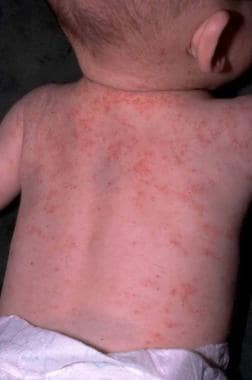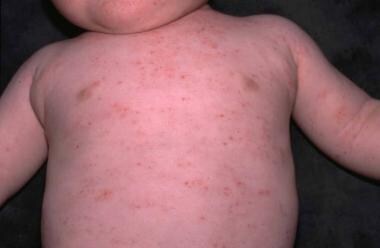Bastida JM, Del Rey M, Revilla N, Benito R, Perez-Andrés M, González B, et al. Wiskott-Aldrich syndrome in a child presenting with macrothrombocytopenia. Platelets. 2016 Nov 25. 1-4. [QxMD MEDLINE Link].
Derry JM, Ochs HD, Francke U. Isolation of a novel gene mutated in Wiskott-Aldrich syndrome. Cell. 1994 Aug 26. 78 (4):635-44. [QxMD MEDLINE Link].
Tyler JJ, Allwood EG, Ayscough KR. WASP family proteins, more than Arp2/3 activators. Biochem Soc Trans. 2016 Oct 15. 44 (5):1339-1345. [QxMD MEDLINE Link].
Guillén-Rocha N, López-Rocha E, Danielian S, Segura-Méndez N, López-González L, Lugo-Reyes SO. [Wiskott-Aldrich syndrome. A report of a new mutation]. Rev Alerg Mex. 2014 Jul-Sep. 61(3):219-23. [QxMD MEDLINE Link].
Silvin C, Belisle B, Abo A. A role for Wiskott-Aldrich syndrome protein in T-cell receptor-mediated transcriptional activation independent of actin polymerization. J Biol Chem. 2001 Jun 15. 276(24):21450-7. [QxMD MEDLINE Link].
Rivers E, Thrasher AJ. Wiskott-Aldrich syndrome protein: Emerging mechanisms in immunity. Eur J Immunol. 2017 Nov. 47 (11):1857-1866. [QxMD MEDLINE Link].
Pulecio J, Tagliani E, Scholer A, et al. Expression of Wiskott-Aldrich syndrome protein in dendritic cells regulates synapse formation and activation of naive CD8+ T cells. J Immunol. 2008 Jul 15. 181(2):1135-42. [QxMD MEDLINE Link].
Jia D, Gomez TS, Metlagel Z, Umetani J, Otwinowski Z, Rosen MK, et al. WASH and WAVE actin regulators of the Wiskott-Aldrich syndrome protein (WASP) family are controlled by analogous structurally related complexes. Proc Natl Acad Sci U S A. 2010 Jun 8. 107(23):10442-7. [QxMD MEDLINE Link]. [Full Text].
Perry GS 3rd, Spector BD, Schuman LM, et al. The Wiskott-Aldrich syndrome in the United States and Canada (1892-1979). J Pediatr. 1980 Jul. 97(1):72-8. [QxMD MEDLINE Link].
Conley ME, Wang WC, Parolini O, Shapiro DN, Campana D, Siminovitch KA. Atypical Wiskott-Aldrich syndrome in a girl. Blood. 1992 Sep 1. 80(5):1264-9. [QxMD MEDLINE Link].
Cotelingam JD, Witebsky FG, Hsu SM, Blaese RM, Jaffe ES. Malignant lymphoma in patients with the Wiskott-Aldrich syndrome. Cancer Invest. 1985. 3(6):515-22. [QxMD MEDLINE Link].
Vignesh P, Suri D, Rawat A, Lau YL, Bhatia A, Das A, et al. Sclerosing cholangitis and intracranial lymphoma in a child with classical Wiskott-Aldrich syndrome. Pediatr Blood Cancer. 2017 Jan. 64 (1):106-109. [QxMD MEDLINE Link].
Kritikou JS, Dahlberg CI, Baptista MA, Wagner AK, Banerjee PP, Gwalani LA, et al. IL-2 in the tumor microenvironment is necessary for Wiskott-Aldrich syndrome protein deficient NK cells to respond to tumors in vivo. Sci Rep. 2016 Aug 1. 6:30636. [QxMD MEDLINE Link].
Tanyildiz HG, Dincaslan H, Yavuz G, Unal E, Ikinciogulları A, Dogu F, et al. Lymphoma Secondary to Congenital and Acquired Immunodeficiency Syndromes at a Turkish Pediatric Oncology Center. J Clin Immunol. 2016 Oct. 36 (7):667-76. [QxMD MEDLINE Link].
Yamada M, Ariga T, Kawamura N, et al. Determination of carrier status for the Wiskott-Aldrich syndrome by flow cytometric analysis of Wiskott-Aldrich syndrome protein expression in peripheral blood mononuclear cells. J Immunol. 2000 Jul 15. 165(2):1119-22. [QxMD MEDLINE Link].
Zaninetti C, Gresele P, Bertomoro A, Klersy C, De Candia E, Veneri D, et al. Eltrombopag for the treatment of inherited thrombocytopenias: a phase 2 clinical trial. Haematologica. 2019 Jul 4. [QxMD MEDLINE Link].
Frączkiewicz J, Sęga-Pondel D, Kazanowska B, Ussowicz M. Eltrombopag Therapy in Children With Rare Disorders Associated With Thrombocytopenia. J Pediatr Hematol Oncol. 2019 Jun 12. [QxMD MEDLINE Link].
Sellars WA, South MA. Wiskott-Aldrich syndrome with 18-year survival. Treatment with transfer factor. Am J Dis Child. 1975 May. 129(5):622-7. [QxMD MEDLINE Link].
Mullen CA, Anderson KD, Blaese RM. Splenectomy and/or bone marrow transplantation in the management of the Wiskott-Aldrich syndrome: long-term follow-up of 62 cases. Blood. 1993 Nov 15. 82(10):2961-6. [QxMD MEDLINE Link].
Dupre L, Marangoni F, Scaramuzza S, et al. Efficacy of gene therapy for Wiskott-Aldrich syndrome using a WAS promoter/cDNA-containing lentiviral vector and nonlethal irradiation. Hum Gene Ther. 2006 Mar. 17(3):303-13. [QxMD MEDLINE Link].
Boztug K, Schmidt M, Schwarzer A, Banerjee PP, Díez IA, Dewey RA, et al. Stem-cell gene therapy for the Wiskott-Aldrich syndrome. N Engl J Med. 2010 Nov 11. 363(20):1918-27. [QxMD MEDLINE Link]. [Full Text].
Williams DA. Curing genetic disease with gene therapy. Trans Am Clin Climatol Assoc. 2014. 125:122-9. [QxMD MEDLINE Link]. [Full Text].
Singh S, Khan I, Khim S, Seymour B, Sommer K, Wielgosz M, et al. Safe and Effective Gene Therapy for Murine Wiskott-Aldrich Syndrome Using an Insulated Lentiviral Vector. Mol Ther Methods Clin Dev. 2017 Mar 17. 4:1-16. [QxMD MEDLINE Link].
Booth C, Romano R, Roncarolo MG, Thrasher AJ. Gene therapy for primary immunodeficiency. Hum Mol Genet. 2019 Jul 11. [QxMD MEDLINE Link].
Ferrua F, Cicalese MP, Galimberti S, et al. Lentiviral haemopoietic stem/progenitor cell gene therapy for treatment of Wiskott-Aldrich syndrome: interim results of a non-randomised, open-label, phase 1/2 clinical study. Lancet Haematol. 2019 May. 6 (5):e239-e253. [QxMD MEDLINE Link].
Candotti F. Gene therapy for Wiskott-Aldrich syndrome: here to stay. Lancet Haematol. 2019 May. 6 (5):e230-e231. [QxMD MEDLINE Link].
Corash L, Shafer B, Blaese RM. Platelet-associated immunoglobulin, platelet size, and the effect of splenectomy in the Wiskott-Aldrich syndrome. Blood. 1985 Jun. 65(6):1439-43. [QxMD MEDLINE Link].
Syrigos KN, Makrilia N, Neidhart J, Moutsos M, Tsimpoukis S, Kiagia M, et al. Prolonged survival after splenectomy in Wiskott-Aldrich syndrome: a case report. Ital J Pediatr. 2011 Sep 10. 37:42. [QxMD MEDLINE Link]. [Full Text].
 Eczematous lesions in Wiskott-Aldrich syndrome. The lesion is essentially indistinguishable from that of atopic dermatitis except for the presence of purpura and petechiae.
Eczematous lesions in Wiskott-Aldrich syndrome. The lesion is essentially indistinguishable from that of atopic dermatitis except for the presence of purpura and petechiae.






